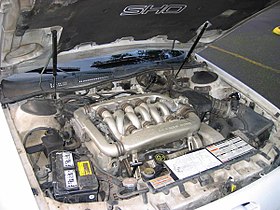This article needs additional citations for verification. (August 2010) |
| Ford SHO V6 | |
|---|---|
 | |
| Overview | |
| Manufacturer | Yamaha Motor Corporation |
| Production | 1989–1995 |
| Layout | |
| Configuration | Naturally aspirated 60° V6 |
| Displacement | 3.0 L; 182.2 cu in (2,986 cc) 3.2 L; 194.7 cu in (3,191 cc) |
| Cylinder bore | 89 mm (3.5 in) 92 mm (3.62 in) |
| Piston stroke | 80 mm (3.15 in) |
| Cylinder block material | Iron |
| Cylinder head material | Aluminum |
| Valvetrain | DOHC 24-valve |
| RPM range | |
| Max. engine speed | 7000 |
| Combustion | |
| Fuel system | Fuel injection |
| Fuel type | Gasoline |
| Cooling system | Water-cooled |
| Output | |
| Power output | 220 hp (164 kW) at 6200 rpm (3.0L) 220 hp (164 kW) at 6000 rpm (3.2L) |
| Torque output | 200 lb⋅ft (271 N⋅m) at 4800 rpm (3.0L) 215 lb⋅ft (292 N⋅m) at 4000 rpm (3.2L) |
| Chronology | |
| Successor | Ford SHO V8 |
The Ford SHO V6 is a family of DOHC V6 engines fitted to the Ford Taurus SHO from 1989 to 1995. The designation SHO denotes Super High Output.[1]
Due to the engine's unusual and aesthetically pleasing appearance it is sometimes transplanted into other vehicles. Its distinctive variable length intake manifold is bilaterally symmetrical, so it can be rotated 180 degrees (making it face "backwards" on the engine, relative to its original installation orientation) to ease the engine's transition from transverse to longitudinal mounting.[2][3][4][5][6][7]
The SHO engines share a common bell housing pattern with the following Ford engines: the 2.3/2.5 L FWD HSC I4, the 3.0 L FWD/RWD Vulcan V6, and the 3.8 L FWD Canadian Essex V6.[8] In 1996, Ford discontinued the SHO V6 and began fitting the Taurus SHOs with the SHO 3.4 L V8 and the Ford AX4N automatic transmission.
- ^ "Taurus/Sable Spotter's Guide (Generation 1, 1986-1991)#1989". Taurus Car Club of America. Archived from the original on 2008-04-11.
- ^ Tann, Jeff. "Vargas' Beauty: Smooth, Shiny, Intoxicating & Exotic Describe This '37 Ford Coupe". Rod and Custom (March 1999): 115–118.
- ^ Boughn, Warren. "SHO Time: Installing a SHO Taurus Engine in a Street Rod". Rod and Custom (May 2000): 121–124.
- ^ "SHO 37 Ford article copy". Archived from the original on 2011-07-13.
- ^ "SHO Rod article copy". Archived from the original on 2011-07-13.
- ^ "SHO engine with other Ford Transmissions". Archived from the original on March 14, 2012.
- ^ "SHO V6 in a Healey". Retrieved 2012-08-17.
- ^ "Wayback archive of Ford Bellhousing information site". Archived from the original on 2003-09-07.